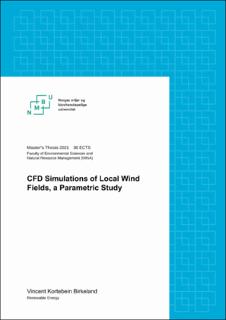| dc.contributor.advisor | Adaramola, Muyiwa Samuel | |
| dc.contributor.advisor | Gravdahl, Arne Reidar | |
| dc.contributor.author | Birkeland, Vincent Kortebein | |
| dc.coverage.spatial | Norway | en_US |
| dc.date.accessioned | 2022-02-21T13:07:44Z | |
| dc.date.available | 2022-02-21T13:07:44Z | |
| dc.date.issued | 2021 | |
| dc.identifier.uri | https://hdl.handle.net/11250/2980540 | |
| dc.description.abstract | Establishing the local wind fields using a simulation software is an important part of the wind resource assessment. In this study the WindSim software, utilizing the Computational Fluid Dynamics (CFD) method, is used to simulate the local wind fields in an area in Southwest Norway. A total of 20 digital terrain model grids are created. Every grid has different numerical settings, with respect to the horizontal- and vertical resolution, domain buffer size and refinement area size. By comparing the vertical profiles at 29 specific turbine positions, the same positions in all 20 cases, the sensitivity of the parameters can be analysed.
When performing CFD simulations of the wind fields the assumption is that a higher resolution model produces more accurate results. The main challenges of utilizing finer grids in CFD modelling today is the time consumption. The present exponential growth in computing power and the introduction of cloud computing will reduce these challenges greatly. The latter without investing in expensive local high-end computers.
The sensitivity study reveals significant differences in the results with respect to the set grid parameters. The most sensitive parameter is the horizontal resolution of the grid. Higher resolution grids typically increase the variability of the results, giving higher maximum values and lower minimum values. | en_US |
| dc.description.abstract | Etablering av de lokale vindfeltene ved hjelp av en simuleringsprogramvare er en viktig del av enhver vindressursvurdering. I denne studien brukes WindSim-programvaren, som benytter numerisk fluiddynamikk metoden, for å simulere de lokale vindfeltene i et område Sørvest i Norge. Det lages totalt 20 digitale terrengmodeller. Hver modell har forskjellige numeriske innstillinger, med hensyn til horisontal- og vertikal oppløsning, størrelse på domene buffer og avgrensningsområde. Ved å sammenligne vertikale profiler for 29 spesifikke turbinposisjoner, likt for alle 20 modeller, kan sensitiviteten til parameterne analyseres.
Ved simulering av vindfelt antas det at en modell med høyere oppløsning gir mer nøyaktige resultater. Hovedutfordringen ved å bruke høyere oppløsning i numerisk fluiddynamikk i dag, er tidsforbruket. Den eksponentielle veksten i datakraft og introduksjon av sky-løsninger vil redusere disse utfordringene betraktelig. Sistnevnte uten å investere i kostbare lokale avanserte datamaskiner.
Sensitivitetsstudien avdekker betydelige forskjeller i resultatene med hensyn til de ulike numeriske innstillingene. Den mest sensitive parameteren er den horisontale oppløsningen. Modeller med høyere oppløsning øker vanligvis variasjonen i resultatene, og gir høyere maksverdier og lavere minimumsverdier. | en_US |
| dc.language.iso | eng | en_US |
| dc.publisher | Norwegian University of Life Sciences, Ås | en_US |
| dc.rights | Attribution-NonCommercial-NoDerivatives 4.0 Internasjonal | * |
| dc.rights | Attribution-NonCommercial-NoDerivatives 4.0 Internasjonal | * |
| dc.rights | Attribution-NonCommercial-NoDerivatives 4.0 Internasjonal | * |
| dc.rights.uri | http://creativecommons.org/licenses/by-nc-nd/4.0/deed.no | * |
| dc.title | CFD simulations of local wind fields : a parametric study | en_US |
| dc.type | Master thesis | en_US |
| dc.description.localcode | M-FORNY | en_US |

